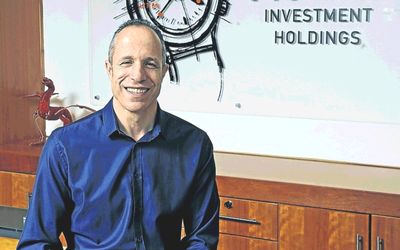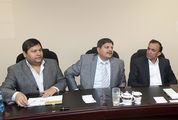PAVLO’S PERSPECTIVE: An abundance mind-set creates world leading innovations
by Pavlo Phitidis,
2015-06-09 06:17:47.0
THE advent of agriculture was a seminal moment in the advancement of our species. It allowed settlements to grow, provided food security and allowed societies to grow and prosper.
Then it faltered. Crop yields fell and leaders struggled to explain why. Sages were deployed to seek reprieve and they found it.
An innovation in farming, crop rotation and irrigation was adopted in societies further afield with great success. This led to the modernisation of farming and ushered in growth in societies over time.
A crisis created by limitations was solved by modernising farming techniques. There are some lessons to be learned in this brief history of innovation.
Modernisation occurs when we recognise that the limits we reach prevents the advancement of our society and a unified vision of a future alternative is needed. Innovation is born from multiple debates, with multiple parties and the extensive experimentation.
SA’s mining sector faces a similar crisis. Socioeconomic pressures, deepening mines, unreliable energy supplies and lower-grade ore bodies deepen the crisis every day.
In dealing with the crisis, conflicting mind-sets delay resolution. A scarcity mind-set sees mining as a scarce, limited resource. The abundance mind-set views mining as a catalysing agent for economic prosperity beyond the life of a mine’s mineral deposit.
The scarcity debate leads to a zero-sum game and is riddled with conflict and mistrust. The abundance mind-set is harder to bring about. It requires big thinking and a bold vision to unlock the potential that a vibrant mining sector can bring to a society’s advancement. Driven by modernisation, this option paints a future that goes way beyond limited ore bodies.
We are blessed with such an example. Former South African Elon Musk chairs Tesla, a company built to build electric cars. An unintended consequence has been the development of a solar-charged home battery system that has the potential to take households off-grid.
This is a product invented in one sector with benefits to another. None of this was foreseen when the investment in Tesla was first begun eight years ago.
Could mining not hold the same potential for SA? A modernised mining environment would be one that requires innovations across multiple fronts.
Forged by a future vision attained through collaboration by multiple stakeholders, innovations above and below ground could bring down the cost of mining, improve productivity through upskilling and reduce the risk on lives.
The need for such innovation stretches into policy formulation, water reticulation, energy production, housing, education and health.
Innovations do not occur in isolation. One such mine holding this view is Anglo American Platinum (Amplats). A step in this direction has been the creation of an open-innovation platform.
Entrepreneurs and innovators are being invited to pilot processes, products, technologies and social strategies as partners to derive the innovations that will lift the limits holding the industry back. One such firm, Cyest, working with (Amplats), has brought its brain power in big data and data visualisation to generate 3-D images of conditions 800m underground.
Accelerating the modernisation of a mining industry framed by an abundance mind-set has the potential for SA to lead the sector through excellence.
Collaborating to lift the limits of our mining environment could go further to create a long-tail of value, seeing the innovations developed in the dark recesses of the earth, lead mining in the dark recesses of space. Imagine that, our flag on Mars.
• Phitidis is CEO of Aurik Business Incubator, director of Aurik Enterprise & Supplier Development, entrepreneurship commentator on 702 and Cape Talk and presenter of The Growth Engines

Pavlo Phitidis. Picture: SUPPLIED
THE advent of agriculture was a seminal moment in the advancement of our species. It allowed settlements to grow, provided food security and allowed societies to grow and prosper.
Then it faltered. Crop yields fell and leaders struggled to explain why. Sages were deployed to seek reprieve and they found it.
An innovation in farming, crop rotation and irrigation was adopted in societies further afield with great success. This led to the modernisation of farming and ushered in growth in societies over time.
A crisis created by limitations was solved by modernising farming techniques. There are some lessons to be learned in this brief history of innovation.
Modernisation occurs when we recognise that the limits we reach prevents the advancement of our society and a unified vision of a future alternative is needed. Innovation is born from multiple debates, with multiple parties and the extensive experimentation.
SA’s mining sector faces a similar crisis. Socioeconomic pressures, deepening mines, unreliable energy supplies and lower-grade ore bodies deepen the crisis every day.
In dealing with the crisis, conflicting mind-sets delay resolution. A scarcity mind-set sees mining as a scarce, limited resource. The abundance mind-set views mining as a catalysing agent for economic prosperity beyond the life of a mine’s mineral deposit.
The scarcity debate leads to a zero-sum game and is riddled with conflict and mistrust. The abundance mind-set is harder to bring about. It requires big thinking and a bold vision to unlock the potential that a vibrant mining sector can bring to a society’s advancement. Driven by modernisation, this option paints a future that goes way beyond limited ore bodies.
We are blessed with such an example. Former South African Elon Musk chairs Tesla, a company built to build electric cars. An unintended consequence has been the development of a solar-charged home battery system that has the potential to take households off-grid.
This is a product invented in one sector with benefits to another. None of this was foreseen when the investment in Tesla was first begun eight years ago.
Could mining not hold the same potential for SA? A modernised mining environment would be one that requires innovations across multiple fronts.
Forged by a future vision attained through collaboration by multiple stakeholders, innovations above and below ground could bring down the cost of mining, improve productivity through upskilling and reduce the risk on lives.
The need for such innovation stretches into policy formulation, water reticulation, energy production, housing, education and health.
Innovations do not occur in isolation. One such mine holding this view is Anglo American Platinum (Amplats). A step in this direction has been the creation of an open-innovation platform.
Entrepreneurs and innovators are being invited to pilot processes, products, technologies and social strategies as partners to derive the innovations that will lift the limits holding the industry back. One such firm, Cyest, working with (Amplats), has brought its brain power in big data and data visualisation to generate 3-D images of conditions 800m underground.
Accelerating the modernisation of a mining industry framed by an abundance mind-set has the potential for SA to lead the sector through excellence.
Collaborating to lift the limits of our mining environment could go further to create a long-tail of value, seeing the innovations developed in the dark recesses of the earth, lead mining in the dark recesses of space. Imagine that, our flag on Mars.
• Phitidis is CEO of Aurik Business Incubator, director of Aurik Enterprise & Supplier Development, entrepreneurship commentator on 702 and Cape Talk and presenter of The Growth Engines























Change: -0.47%
Change: -0.57%
Change: -1.76%
Change: -0.34%
Change: 0.02%
Data supplied by Profile Data
Change: -1.49%
Change: 0.08%
Change: -0.47%
Change: 0.00%
Change: -0.04%
Data supplied by Profile Data
Change: -0.34%
Change: 0.03%
Change: -0.10%
Change: -0.22%
Change: -0.81%
Data supplied by Profile Data
Change: -0.28%
Change: -1.15%
Change: -0.07%
Change: -1.21%
Change: -0.22%
Data supplied by Profile Data